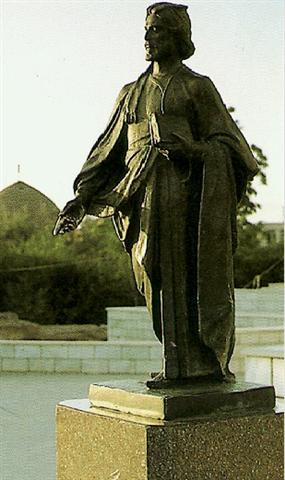Below is a short report first issued by Iran’s Press TV entitled “Baku to replace Persian-inscribed tiles at Nezami mausoleum” (September, 12, 2013) (see also Payvand News (September 18, 2013) report entitled “INLA asks Azerbaijan to stop replacement of Persian inscriptions of Nezami’s tomb“). Kindly note that the pictures and accompanying captions inserted below did not appear in the original Press TV report.
Before reading the report, readers are invited to consult:
Lornejad, S., & Doostzadeh, A. (2012). On the Modern Politicization of the Persian poet Nizami Ganjavi. Yerevan Series for Oriental Studies (Volume I), Edited by Garnik S. Asatrian. Yerevan: Caucasian Centre for Iranian Studies. (pdf) – NOTE: This is the Official Digitized Version by Victoria Arakelova; with errata fixed from the print edition.
================================================================
An Azeri official says the Persian-inscribed tiles in the mausoleum of renowned Iranian poet Nezami Ganjavi will be replaced with the Azeri translation of his poems.
Director of Nizami Ganjavi Centre of Azerbaijan National Academy of Sciences (ANAS) Khalil Yusifli said the poet’s chosen poems inscribed on tiles were translated into Azeri from Persian.
Earlier this month, the Azeri government destroyed all tiles with Persian inscription on them at the mausoleum in Ganja using restoration work as a pretext for the measure.
On August 19, Iran’s Foreign Ministry Spokesman Abbas Araqchi expressed regret over Azerbaijan’s reported move at the Nezami Ganjavi mausoleum.
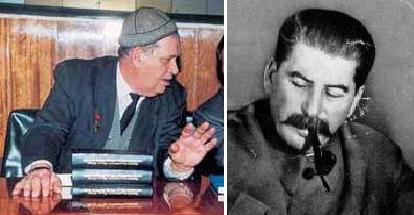 Falsifiers of history: the late Ziya Bonyadov (1921-1997) (left) and Joseph Stalin (1878-1953) (right). Stalin referred to Iranian historical icons such as Nizami Ganjavi as “Azarbaijani historical figures”. Stalin’s myths (called “Stalin’s school of historical falsification by Leon Trotsky) have been adopted by the modern day citizens of the Republic of Azarbaijan. Ziya Bonyadov for example deliberately falsified history to omit the fact that Babak Khorramdin is identified as a Persian in ancient sources. Instead, he promoted Stalinist terminology which is essentially Persophobic.
Falsifiers of history: the late Ziya Bonyadov (1921-1997) (left) and Joseph Stalin (1878-1953) (right). Stalin referred to Iranian historical icons such as Nizami Ganjavi as “Azarbaijani historical figures”. Stalin’s myths (called “Stalin’s school of historical falsification by Leon Trotsky) have been adopted by the modern day citizens of the Republic of Azarbaijan. Ziya Bonyadov for example deliberately falsified history to omit the fact that Babak Khorramdin is identified as a Persian in ancient sources. Instead, he promoted Stalinist terminology which is essentially Persophobic.
The Azeri government has been waging an extensive campaign to falsify the identity of the renowned 12th-century Persian poet, whose formal name was Jamal ad-Din Abu Muhammad Ilyas ibn-Yusuf ibn-Zakki.
In 2012, the Heydar Aliyev Foundation, which is run by Azerbaijan’s first lady Mehriban Aliyeva, paid Rome City Municipality EUR 110,000 to install a monument of Nezami in the Villa Borghese Park in the Italian capital. Meanwhile, Baku has introduced Nezami as an Azeri poet in all the country’s text books. This is while Nezami (1141 to 1209) has not written any poems in Azeri, and the Republic of Azerbaijan gained independence from Russia only 22 years ago. ===================================================================================== Comments sent to Kavehfarrokh.com —- Original Message —- From: Terence xxxx <xxxxgmail.com> To: Dr. Kaveh Farrokh <manuvera@localhost> Sent: Sun, Sep 15, 2013 5:17 am Subject: Re: Baku to replace Persian-inscribed tiles at Nezami Mausoleum Dear Kaveh, The Turkification policy pursued by the Russians, both Tsarist and Soviet – They in Baku are being torn from their true roots to be given a false identification. To begin with, following Ahmad Kasravi’s word, Azari is properly the term for a Persian dialect, not a Turkic one. Hence, the Tati-, Hazrani- and Taleshi-speakers are the last representatives of the true Azari. Now, of course, the Turkish language was introduced into Azarbaijan only 4 centuries ago. This means that Azaris are Iranians who happen to speak a Turkic dialect. Also, the ‘Turkification’ of Azarbaijan came hand-in-hand with the Shi’fication of it. As a result, in modern-day Azarbaijan, whichever side of the border, Turkic-speakers tend to be Shi’ite and Azari-Persian-speakers Sunni and Sufi (either Qaderi or Naqshbandi), like the Kurds. All the great Azari Sufi masters and poets of the past – Shams-e Tabrizi, Shah Qasem-e Anvâr, Sheikh Mahmud-e Shabestari, Kamâl-e Khojandi (buried in Tabriz), and Mohammad Shirin Maghrebi – were all Persian-speakers, not to speak of the great classical poets Nezami and Khaqani. Only two prominent poets were bi-lingual: Nesimi and the late Shahriyar. Sheikh Safi-ye Ardabili spoke only Persian Azari, which is close to the Gilaki of his master Sheikh Zahed-e Gilani. In the biography of Sheikh Safi – Safvat as-safâ – conversations between master and disciple are quoted in the popular language of the two, i.e., Azari Persian and Gilaki. Finally, who is the greatest son of Azarbaijan in all of history? Zoroaster, who spoke not a word of Turkish! How do we get this point across dear Kaveh? Cheers, Terence ===================================================================================== From: Fazli xxxx <[email protected]> To: Dr. Kaveh Farrokh <manuvera@localhost> Sent: Fri, Sep 13, 2013 4:53 pm Subject: Re: Baku to replace Persian-inscribed tiles at Nezami Mausoleum Kaveh Jan, It is interesting that the level of misinformation and political muckraking is degenerating to this point. It seems that pure imagination and political expediency has taken precedence over historical facts. Has any of these people even heard of Minorsky’s “A History of Sharvan and Darband in the 10th-11th Centuries”, Cambridge, 1958? In his book, Vladimir Minorsky has photographs of the gateway in Derband that is attributed to the Sassani time. Derband (Derbent) is north of Baku so by definition Baku was Sassani territory. He also mentions that there was a wall built by the Sassani extending from Derband on the Caspian coast toward the Black sea. His estimate was the the wall was 40 km (I have to check this number) and the rest of the distance was guarded by fortifications that I assume were similar to Ghaleh Babak. The wall I refer to is mentioned in Minorsky pages 87-90. On page 87 Minorsky has a map and identifies a northern wall built by Khusrau Anushirvan 531-578 Ad and a southern wall built by Qubad 488-531 AD. These walls were dismantled and rebuilt many many times in the following centuries, but they were so massive that some sections are still existing today (see attached photo from Minorsky). Minorsky specifically mentions that Masudi, an early geographer, claimed the walls were 200 km but he says that realistically they were 15 km with another 25 KM covered with fortifications. Minorsky quotes extensively from Monajem Bashi “trarik bab al awab” recording events of around the first millinium AD. At that time apparently the “Turks were new invaders” – Minorsky page 3. The travels of Ibn Fadlan are described in “Ibn Fadlan’s Journey to Russia” by Richard Frye. (attached is the map, page 13). Even Frye raise the question of why Ibn Fadlan made such a long detour and a possible answer is the chaos on the Darbend (also known by the Arabic word “Bab” -meaning door) and Shirvan. Ibn Fadlan was traveling with a large entourage (5,000 men and 3,000 pack animals, page 81) and with such a responsibility it would be prudent to avoid an area which was not really secure. The Arab dominance of the region of Shervan/Derband was never complete and in fact the Arab governors hardly ever set foot it into the region. The area was mostly governed by local tribal clans and/or lords who did or did not look to Bagdad, depending on their proclivity and mood. The map drawn in your link is complete fiction, and no bearing on anything historical. A better map is shown in Minorsky’s book which has historic references as a base. It is interesting that during the time of Caliph al Moghtadir in the 10th century CE, when Ibn Fadlan was sent as an emissary of the Caliphate to Russia, he chose to traveled thru Khorassan to Russia, since the Shirvan/Derband area of the Caucauses was so independent of the Caliphate, that the writ of the al Moghtadir was worthless. Thus Arab control of the area at best was “iffy” and any Arab map showing political control – if it existed – is imaginary. So the map shown in the link is a figment of someone’s political imagination and politics, to quote a Persian proverb, has neither a father nor a mother. (Siyasat pedar madr nadard) I think the issue of the name of Azerbaijan is self explanatory and requires no further elaboration. Finally I kinda wonder what the Khamseh of Nezami would sound like in Turkish. How would: “pir zani ra setami dar gereft Dast zad o daman sanjar gereft” Be poetically translated?? Best Fazli PS: by the way the city of Derband is a name from Sassani times and referrers to the gate in the Wall separating “Eranshahr” from the ‘barbarians to the north’. Also the very name Azar Baijan, comes from the Pahlavi word “Azar” meaning fire and “baijan” (a corruption of “abadegan”) meaning developed area. One of the major exports of Shirvan/Darband, even during the Sassani, was pitch, i.e., crude oil, which is why the area was named Azar – fire! So, maybe they should also change Azerbaijan to gelismis alani yangin? 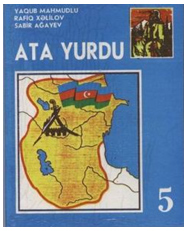 –تبلیغات ضد ایرانی در کتابهای درسی رژیم حاکم بر باکو!-
–تبلیغات ضد ایرانی در کتابهای درسی رژیم حاکم بر باکو!-
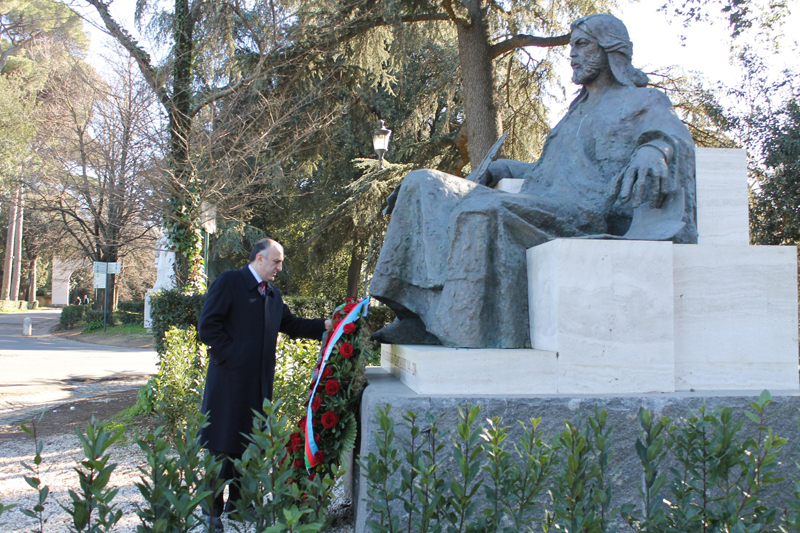 Baku Foreign Minister Elmar Mammadyarov at Nizami Ganjavi monument at Rome’s Villa Borghese park in early February 2013. The Aliev Foundation funded the installation of this statue as part of the initiative of falsifying Iranian historical icons (see Petition to correct the historical identity of the statue in Rome).
Baku Foreign Minister Elmar Mammadyarov at Nizami Ganjavi monument at Rome’s Villa Borghese park in early February 2013. The Aliev Foundation funded the installation of this statue as part of the initiative of falsifying Iranian historical icons (see Petition to correct the historical identity of the statue in Rome).
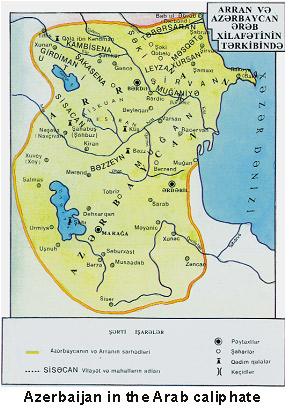 A historically false map published in Baku of an alleged “Greater Azarbaijan” during the Arab Caliphate. Historically all contemporary Islamic sources clearly distinguish between the real-historical Azarbaijan described south of the Araxes River in northwest Iran versus Arran or Albania (re-named “Azerbaijan Republic” in 1918) located to the north of the Araxes River. There are no maps or references that cite ancient Arran in the Caucasus above the Araxes River as “Azarbaijan”.
A historically false map published in Baku of an alleged “Greater Azarbaijan” during the Arab Caliphate. Historically all contemporary Islamic sources clearly distinguish between the real-historical Azarbaijan described south of the Araxes River in northwest Iran versus Arran or Albania (re-named “Azerbaijan Republic” in 1918) located to the north of the Araxes River. There are no maps or references that cite ancient Arran in the Caucasus above the Araxes River as “Azarbaijan”.

